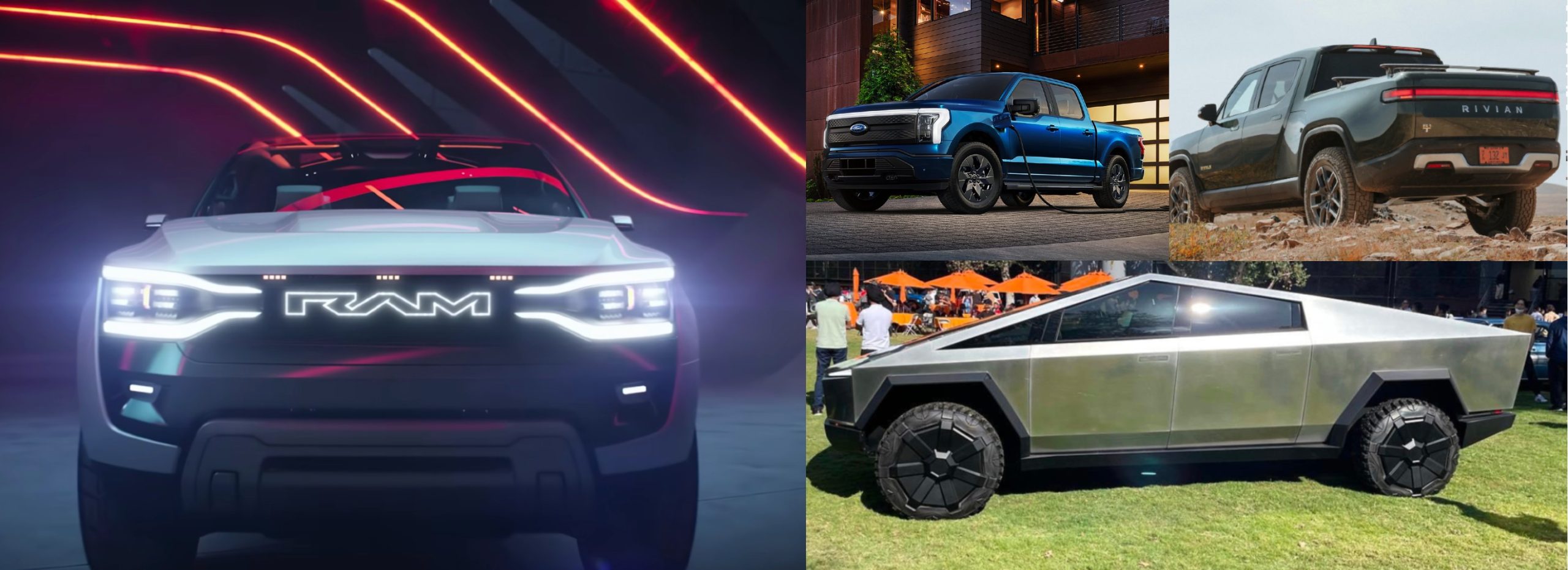
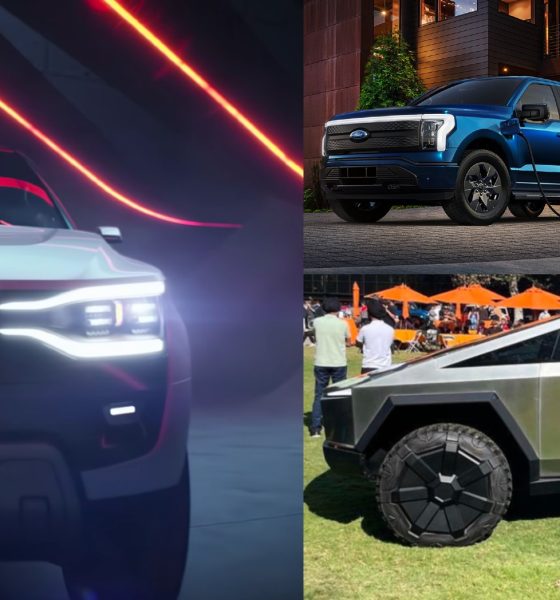
News
Stellantis RAM 1500 Revolution vs Tesla Cybertruck, Rivian R1T & the Ford F-150 Lightning
Stellantis’ Ram Truck brand revealed its RAM 1500 Revolution battery electric vehicle concept during CES 2023 in Las Vegas. The all-electric RAM pickup has already generated some buzz in the market for its exciting features and next-gen design. With the growing electrified pickup truck market, RAM has developed a strong contender with the 1500 Revolution BEV.
RAM 1500 Revolution BEV Details
The RAM 1500 Revolution BEV will be built on Stellantis’ STLA Frame EV platform, designed to deliver a range of up to 500 miles (800 km). Unlike other STLA platforms—which are unibody—the STLA Frame platform is a body-on-frame. In the past, Stellantis planned to use 2 battery cell chemistries to ensure affordability in its electric vehicles. The company will have to carefully consider the RAM 1500 Revolution’s starting price if it wants the pickup to qualify for tax incentives under the Inflation Reduction Act.
The electrified RAM 1500 Revolution concept includes some nifty tech innovations, including digital side-view mirrors. The rearview mirror alone is packed with tech, like a smart backup camera with 360-degree views, plus speakers and receivers compatible with voice assistants like Alexa and Siri. The review mirror is connected to biometric cameras, which observe the RAM 1500 Revolution’s surrounding environment.
With its EV pickup concept, RAM plans to take advantage of the most useful tech innovations on the market. For instance, the biometric cameras appear connected to the EV pickup truck’s biometric identity recognition and two-factor authentication. The RAM 1500 BEV also utilizes augmented reality (AR) for a see-through heads-up display (HUD). Other features RAM plans for the 1500 Revolution BEV are Shadow Mode and an exterior projector.

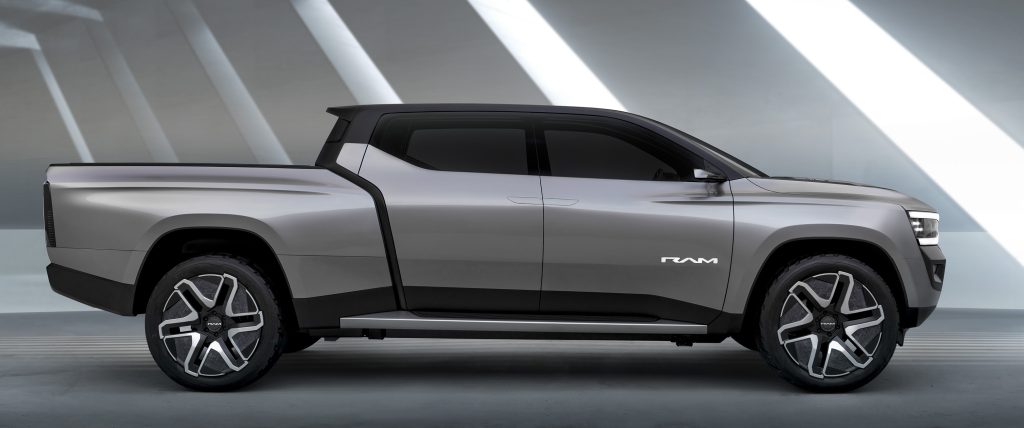
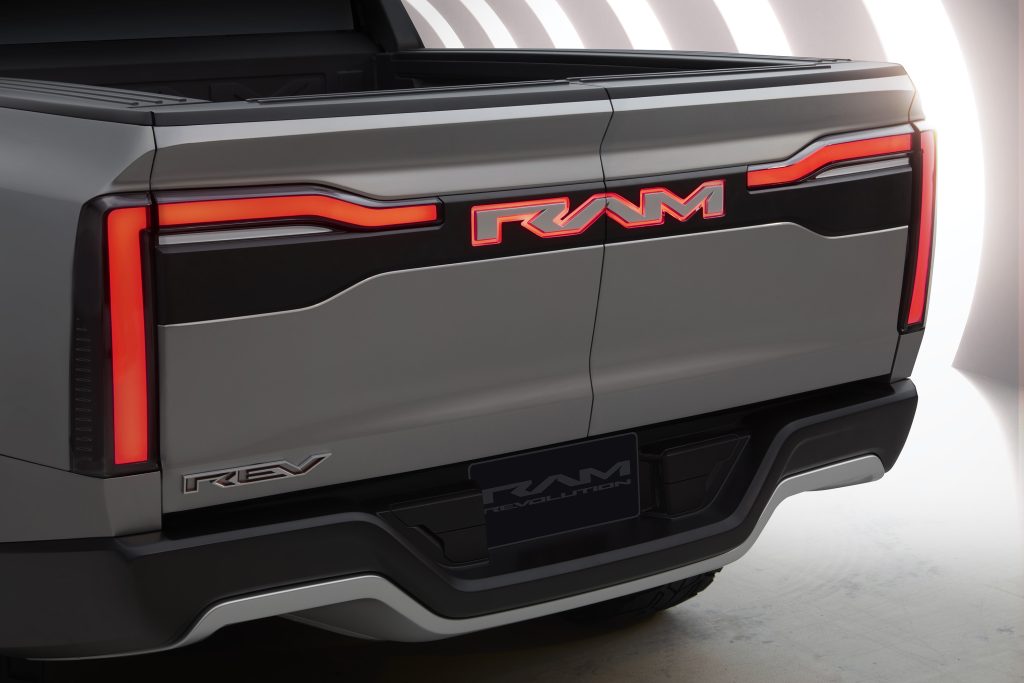

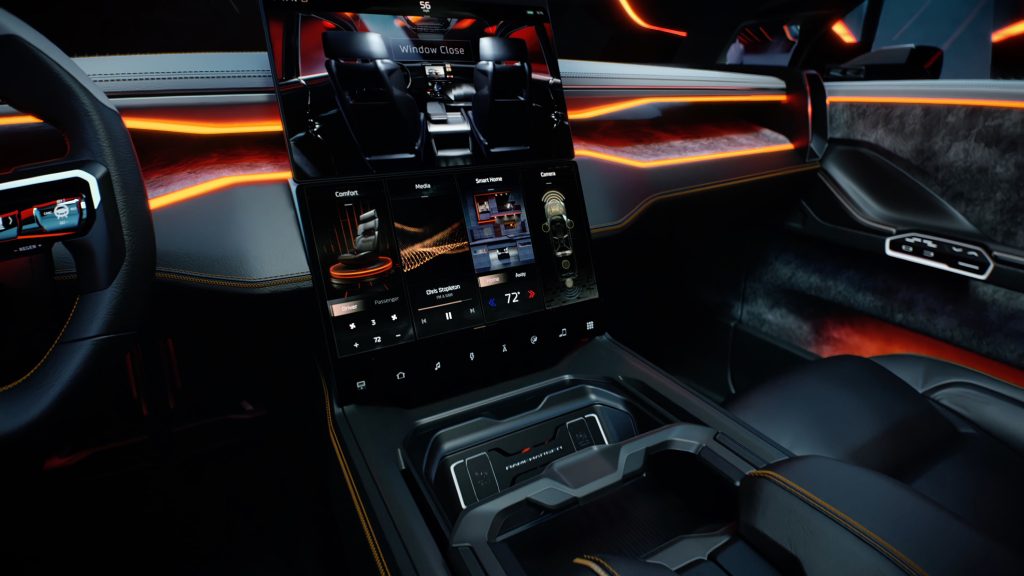
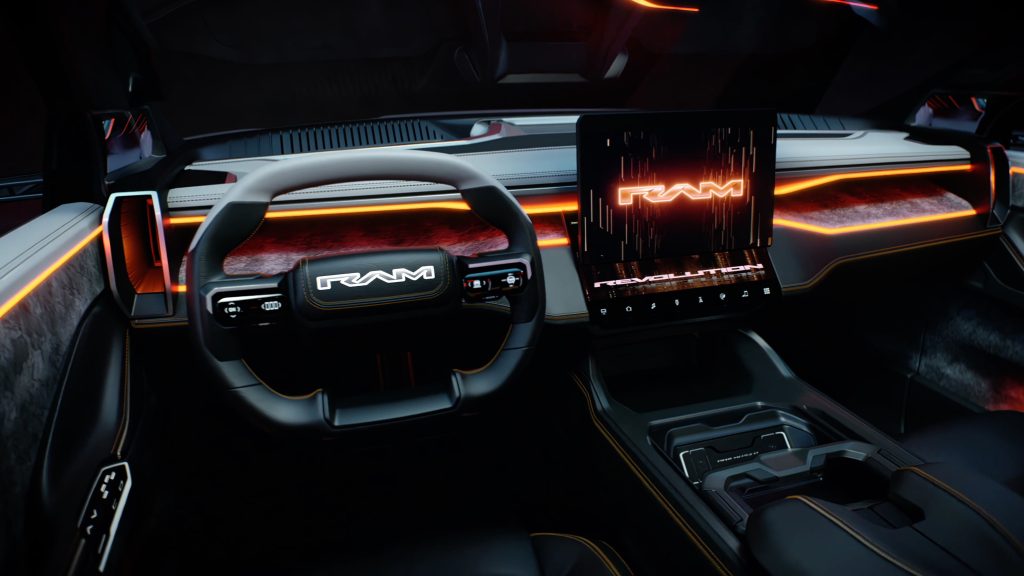
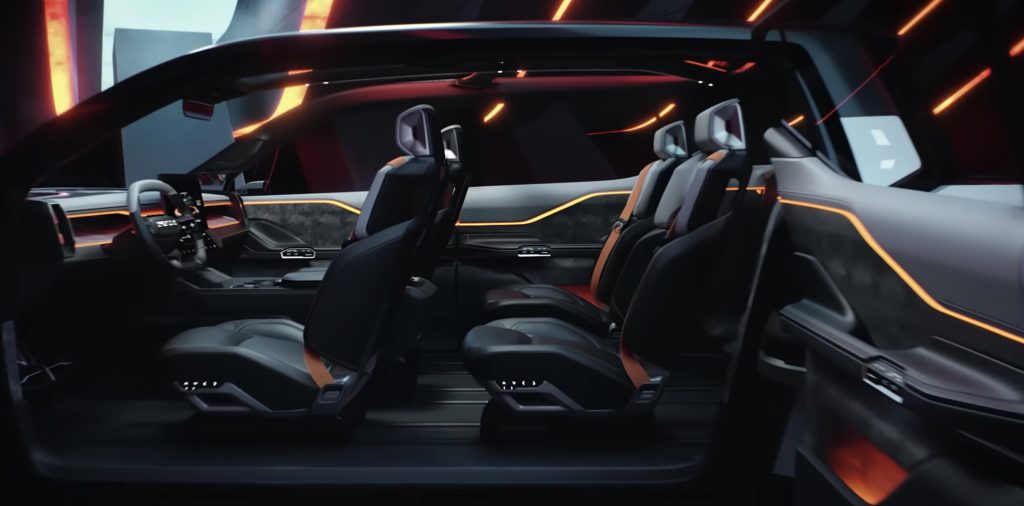
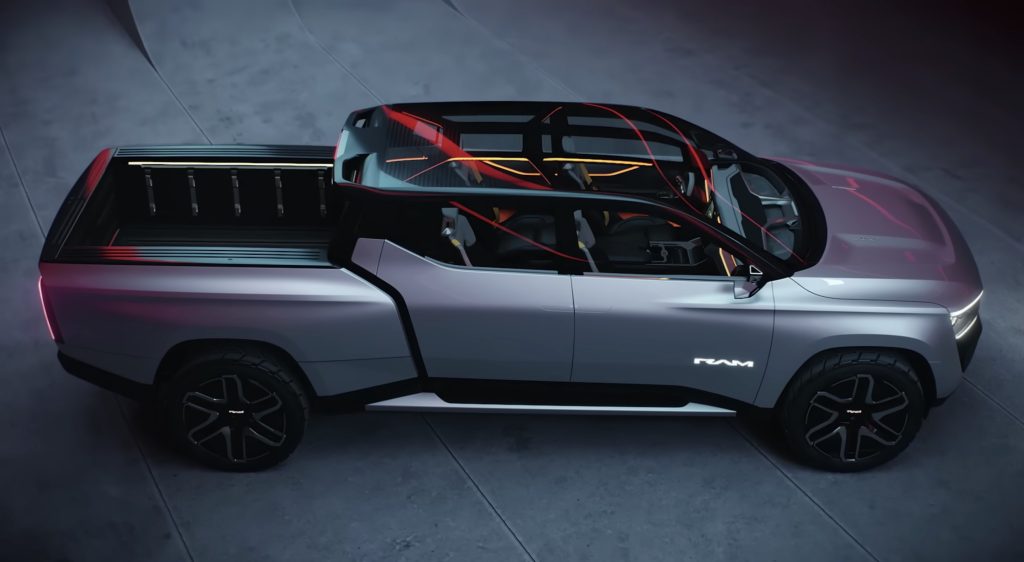
RAM vs. Tesla Cybertruck, Rivian R1T & the Ford F-150 Lightning
RAM aims to redefine the pickup truck segment, demonstrating its position in the EV pickup truck market along the way. It is one of North America’s top pickup truck brands, alongside Ford and Chevrolet. The Ram pickup, Ford F-Series pickup, and Chevy Silverado have long held the top three positions in the pickup truck market in the United States. Still, the advent of electric vehicles has opened up the pickup segment to other legacy competitors and EV startups.
Tesla Cybertruck
Tesla unveiled its Cybertruck concept in 2019 and has yet to deliver the futuristic pickup truck. However, Giga Texas has started preparing for Cybertruck production in 2023. Tesla plans to deliver its first batch of Cybertruck units to customers this year.
When the electric truck concept was first revealed, it generated a lot of buzz for its unique design and technology. But other EV trucks have started selling on the market since 2019, so Tesla has improved the Cybertruck’s design and introduced up-to-date technology to the pickup truck. Due to the Cybertruck’s design changes, its prices might also change.
“I worry more about like how do we the Cybertruck affordable despite having awesome technology. That’s the thing that will really set the rate,” Elon Musk said back in the Q4 2021 earnings call.
Rivian R1T
The Rivian R1T has generated some buzz of its own since hitting the market. Rivian’s electric pickup truck appeals to a niche customer base who live for adventure and fun. Rivian literally threw everything into the R1T that an explorer would need—including the kitchen sink.
In preparation for 2023, Rivian has tweaked its R1T configuration options. For instance, the Rivian R1T Quad-Motor with Max battery pack is unavailable this year. However, the company strives to improve its vehicle. Last month, Rivian announced that the 2023 R1T with 21-inch wheels received the highest EPA range estimate for an electric truck in the market.
Ford F-150 Lightning
If Rivian was made for fun and adventure, Ford designed the F-150 Lightning for heavy-duty work. Ford’s all-electric pickup won Motor Trend’s 2023 Pickup Truck of the Year. It was the first electric pickup to win the award with a unanimous vote from the judges.
Ford is steadily ramping up F-150 Lightning production at its Dearborn Truck Plant and Rouge Electric Vehicle Center in Michigan. The legacy automaker initially targeted an annual manufacturing capacity of 40,000 units for the F-150 Lightning. However, demand for the electric pickup seems to be strong since Ford doubled its manufacturing capacity for the Lightning to 80,000 vehicles annually by 2024.
With the RAM 1500 Revolution, Rivian R1T, Ford F-150 Lightning, and Tesla Cybertruck, the electric pickup truck market is starting to take shape. More competitors are likely to come in the future—like Volkswagen’s Scout pickup—making the EV pickup truck market something to watch in the coming years.
The Teslarati team would appreciate hearing from you. If you have any tips, contact me at maria@teslarati.com or via Twitter @Writer_01001101.

Elon Musk
Elon Musk and Tesla AI Director share insights after empty driver seat Robotaxi rides
The executives’ unoccupied tests hint at the rapid progress of Tesla’s unsupervised Robotaxi efforts.

Tesla CEO Elon Musk and AI Director Ashok Elluswamy celebrated Christmas Eve by sharing personal experiences with Robotaxi vehicles that had no safety monitor or occupant in the driver’s seat. Musk described the system’s “perfect driving” around Austin, while Elluswamy posted video from the back seat, calling it “an amazing experience.”
The executives’ unoccupied tests hint at the rapid progress of Tesla’s unsupervised Robotaxi efforts.
Elon and Ashok’s firsthand Robotaxi insights
Prior to Musk and the Tesla AI Director’s posts, sightings of unmanned Teslas navigating public roads were widely shared on social media. One such vehicle was spotted in Austin, Texas, which Elon Musk acknowleged by stating that “Testing is underway with no occupants in the car.”
Based on his Christmas Eve post, Musk seemed to have tested an unmanned Tesla himself. “A Tesla with no safety monitor in the car and me sitting in the passenger seat took me all around Austin on Sunday with perfect driving,” Musk wrote in his post.
Elluswamy responded with a 2-minute video showing himself in the rear of an unmanned Tesla. The video featured the vehicle’s empty front seats, as well as its smooth handling through real-world traffic. He captioned his video with the words, “It’s an amazing experience!”
Towards Unsupervised operations
During an xAI Hackathon earlier this month, Elon Musk mentioned that Tesla owed be removing Safety Monitors from its Robotaxis in Austin in just three weeks. “Unsupervised is pretty much solved at this point. So there will be Tesla Robotaxis operating in Austin with no one in them. Not even anyone in the passenger seat in about three weeks,” he said. Musk echoed similar estimates at the 2025 Annual Shareholder Meeting and the Q3 2025 earnings call.
Considering the insights that were posted Musk and Elluswamy, it does appear that Tesla is working hard towards operating its Robotaxis with no safety monitors. This is quite impressive considering that the service was launched just earlier this year.
Elon Musk
Starlink passes 9 million active customers just weeks after hitting 8 million
The milestone highlights the accelerating growth of Starlink, which has now been adding over 20,000 new users per day.

SpaceX’s Starlink satellite internet service has continued its rapid global expansion, surpassing 9 million active customers just weeks after crossing the 8 million mark.
The milestone highlights the accelerating growth of Starlink, which has now been adding over 20,000 new users per day.
9 million customers
In a post on X, SpaceX stated that Starlink now serves over 9 million active users across 155 countries, territories, and markets. The company reached 8 million customers in early November, meaning it added roughly 1 million subscribers in under seven weeks, or about 21,275 new users on average per day.
“Starlink is connecting more than 9M active customers with high-speed internet across 155 countries, territories, and many other markets,” Starlink wrote in a post on its official X account. SpaceX President Gwynne Shotwell also celebrated the milestone on X. “A huge thank you to all of our customers and congrats to the Starlink team for such an incredible product,” she wrote.
That growth rate reflects both rising demand for broadband in underserved regions and Starlink’s expanding satellite constellation, which now includes more than 9,000 low-Earth-orbit satellites designed to deliver high-speed, low-latency internet worldwide.
Starlink’s momentum
Starlink’s momentum has been building up. SpaceX reported 4.6 million Starlink customers in December 2024, followed by 7 million by August 2025, and 8 million customers in November. Independent data also suggests Starlink usage is rising sharply, with Cloudflare reporting that global web traffic from Starlink users more than doubled in 2025, as noted in an Insider report.
Starlink’s momentum is increasingly tied to SpaceX’s broader financial outlook. Elon Musk has said the satellite network is “by far” the company’s largest revenue driver, and reports suggest SpaceX may be positioning itself for an initial public offering as soon as next year, with valuations estimated as high as $1.5 trillion. Musk has also suggested in the past that Starlink could have its own IPO in the future.
News
NVIDIA Director of Robotics: Tesla FSD v14 is the first AI to pass the “Physical Turing Test”
After testing FSD v14, Fan stated that his experience with FSD felt magical at first, but it soon started to feel like a routine.

NVIDIA Director of Robotics Jim Fan has praised Tesla’s Full Self-Driving (Supervised) v14 as the first AI to pass what he described as a “Physical Turing Test.”
After testing FSD v14, Fan stated that his experience with FSD felt magical at first, but it soon started to feel like a routine. And just like smartphones today, removing it now would “actively hurt.”
Jim Fan’s hands-on FSD v14 impressions
Fan, a leading researcher in embodied AI who is currently solving Physical AI at NVIDIA and spearheading the company’s Project GR00T initiative, noted that he actually was late to the Tesla game. He was, however, one of the first to try out FSD v14.
“I was very late to own a Tesla but among the earliest to try out FSD v14. It’s perhaps the first time I experience an AI that passes the Physical Turing Test: after a long day at work, you press a button, lay back, and couldn’t tell if a neural net or a human drove you home,” Fan wrote in a post on X.
Fan added: “Despite knowing exactly how robot learning works, I still find it magical watching the steering wheel turn by itself. First it feels surreal, next it becomes routine. Then, like the smartphone, taking it away actively hurts. This is how humanity gets rewired and glued to god-like technologies.”
The Physical Turing Test
The original Turing Test was conceived by Alan Turing in 1950, and it was aimed at determining if a machine could exhibit behavior that is equivalent to or indistinguishable from a human. By focusing on text-based conversations, the original Turing Test set a high bar for natural language processing and machine learning.
This test has been passed by today’s large language models. However, the capability to converse in a humanlike manner is a completely different challenge from performing real-world problem-solving or physical interactions. Thus, Fan introduced the Physical Turing Test, which challenges AI systems to demonstrate intelligence through physical actions.
Based on Fan’s comments, Tesla has demonstrated these intelligent physical actions with FSD v14. Elon Musk agreed with the NVIDIA executive, stating in a post on X that with FSD v14, “you can sense the sentience maturing.” Musk also praised Tesla AI, calling it the best “real-world AI” today.








